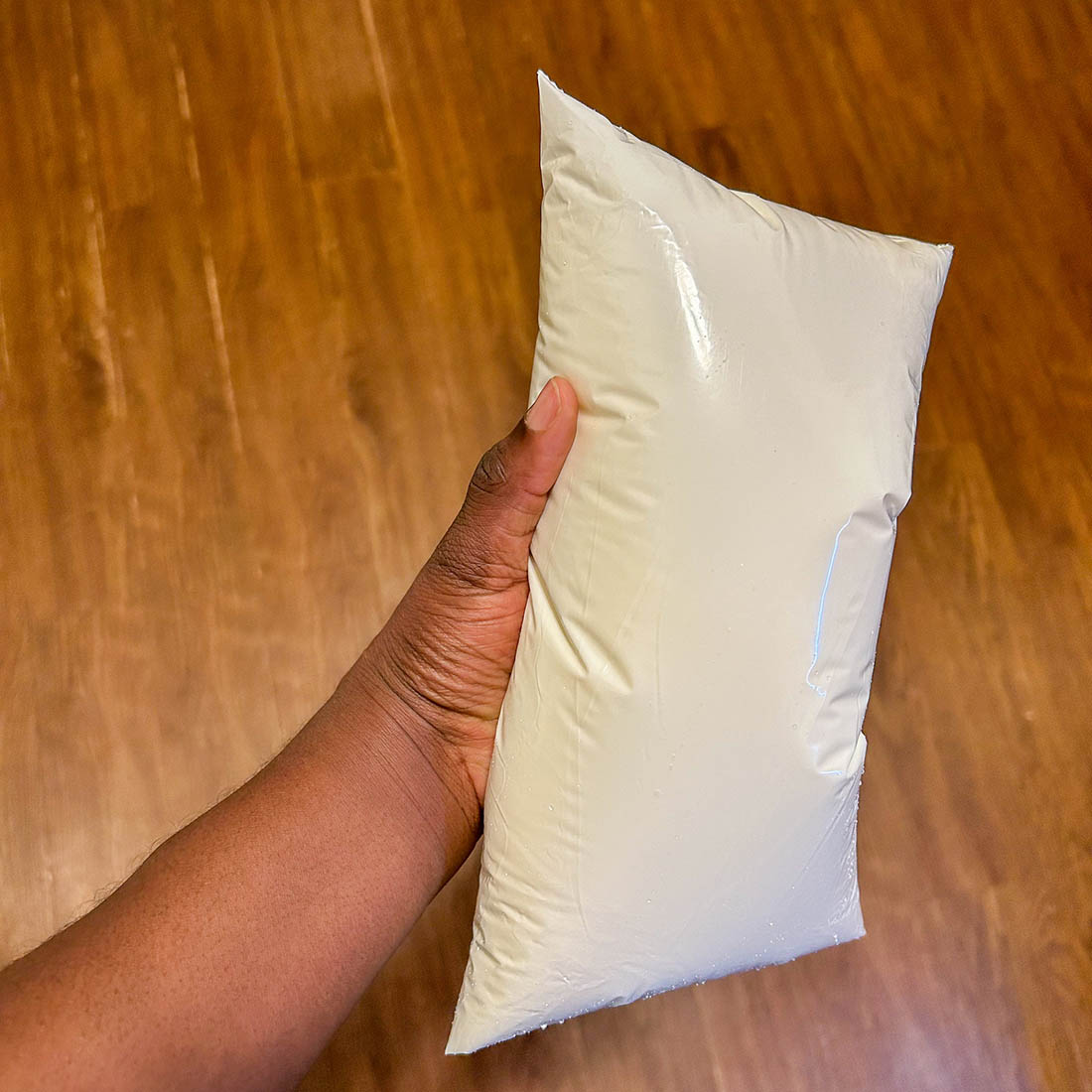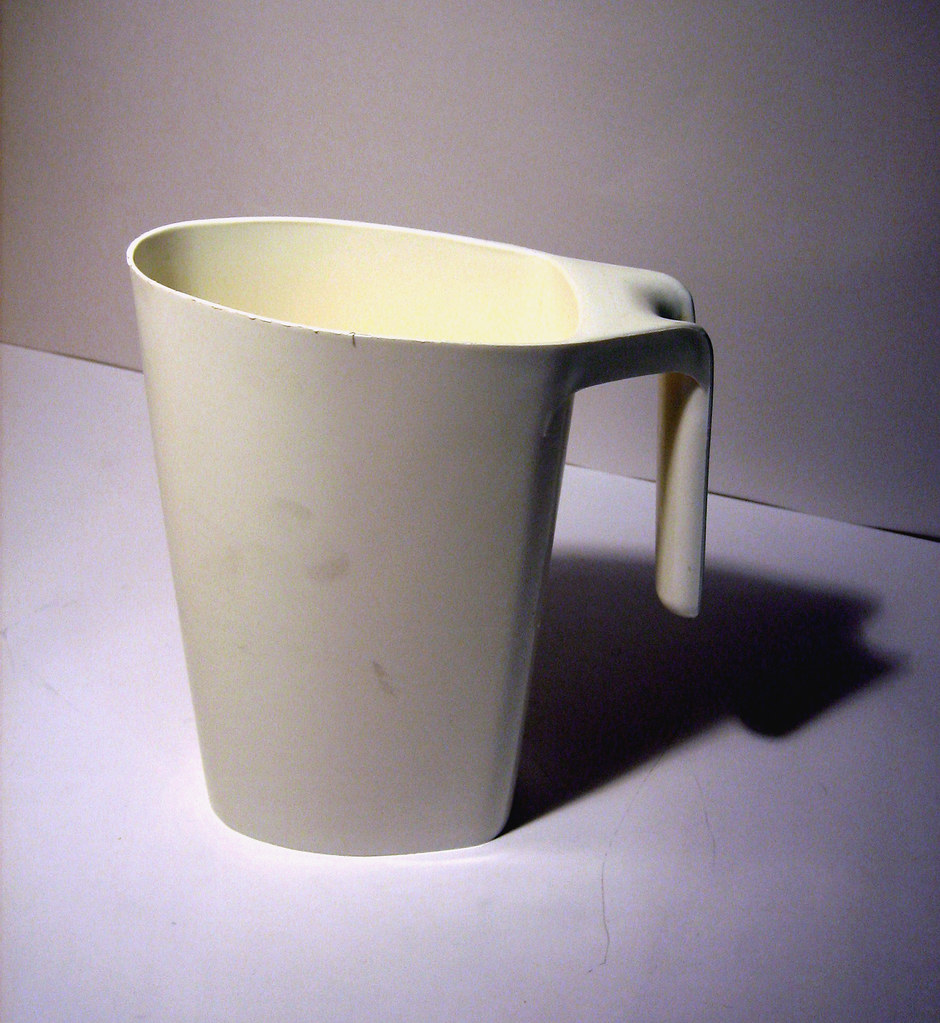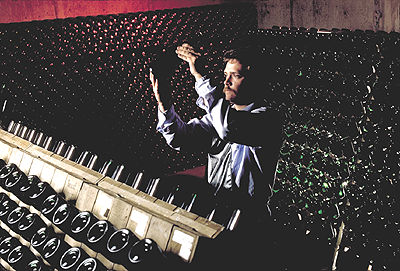A milk bag is a soft plastic pouch used to package milk. It is a packaging method that is common in Canada. Milk bags are not exclusive to Canada, but the use of milk bags have become an emblematic aspect of Canadian culture. It is estimated that roughly half of Canadians purchase their milk from milk bags, and that rate rises to between 75 and 85 percent for Ontario residents.
In parts of Canada—namely the Maritimes, Quebec, and Ontario—the largest volume of milk an individual can purchase at the grocery story is typically 4 litres, sold in a plastic bag that contains three 1 1/3-litre milk pouches. Milk bags are not the exclusive method by which milk is sold in Canada; as in other places, plastic jugs and cardboard cartons are also available. Moreover, milk bags are not common in Western Canada, the Northern territories, or in Newfoundland and Labrador. (See also Dairy Industry.)

What Is It Called?
Milk bag? Bagged milk? Milk pouch? Milk in bags goes by different names, but the formal industry term for a plastic bag that contains milk is in fact a “pillow pouch.”
History
Milk began to be sold in bags in Canada in the late 1960s. Based on technology developed in Europe, DuPont of Canada marketed the thin polyethylene bags, which first appeared in Canada in 1967. By 1969 about 50 dairies across Canada were using milks bags. (See also Dairy Industry.)
One of the principal reasons the dairy industry turned toward milk bags was that the packaging method allowed the industry to transition from using breakable glass bottles. For a time, bagged milk competed with reusable plastic milk jugs in Canada, but the advent of Metrication (also known as Metric Conversion—the adoption of the Metric system, which took place incrementally in Canada in the 1970s and 1980s), cemented the use of milk bags by much of the dairy industry in Canada.
The shift toward milk bags hinged largely on the fact that it was easier to change the size of the bags—which involved reprogramming machinery to change where a cut was made in the plastic—rather than redesigning production lines to create differently sized plastic jugs. Prior to Metrication, milk was often sold measured in imperial quarts. Moreover, changing one-quart bags to 1 1/3-litre bags was relatively simple, and packaging three together would provide just about 4 litres of milk, roughly between an American and a British liquid gallon. All but one Ontario retailer had completed the switch from plastic milk jugs to milk bags by 1983.

Why Is Milk Sold in Bags in Canada?
Aside from the ease with which plastic milk bags could be adapted for the metric system, there were complications with the reusable plastic milk jug system. Some people would reportedly use the jugs to store toxic substances, like weed killer or gasoline, before returning the jugs to the store for a 25-cent deposit. In addition, there were claims that plastic pouches helped keep milk fresher over longer periods of time. Milk bags were further estimated to use about 75 per cent less plastic than jugs and as such were both more economical and more environmentally friendly. Over time plastic milk bags became less expensive than plastic milk jugs, though this was not initially the case. When first introduced, the bags were more expensive, by between six and seven cents.
A relaxation of certain regulations pertaining to the use of the metric system by the government of Brian Mulroney in the 1980s, in addition to the development of more durable hard plastics, led to the disappearance of milk bags from some provinces, such as Alberta and British Columbia. In other provinces, like Ontario, milk bags continued to be used in part due to regulations that required a deposit for plastic milk jugs. Because plastic milk pouches were exempt, Ontario grocers and dairies used plastic milk bags because it was more economical. In other provinces, such as Quebec and Nova Scotia, both bags and jugs are used, and their use is determined in part by consumer demand.
Whether Canadians will continue to buy milk in bags remains to be seen. In 2024, a La Presse article questioned whether there was a future for milk sold in bags. In recent years two-litre cartons have gained in popularity and have largely replaced the four-litre bagged milk format as the number-one seller. Some analysts believe the shrinking size of Canadian families, and the fact that Canadians visit grocery stores more than once a week, may spell the end of milk bags. However, representatives of the dairy industry in Quebec and Ontario counter that assumption. As of 2024, the format is still the most popular option in Ontario and provides milk at a lower cost when compared with other formats.
Milk at a Grocery Store
Milk in bottles, cartons and bags at a grocery store in Toronto, Ontario, 12 May 2023.
(Lance McMillan/Toronto Star via Getty Images)
Milk Bag Peripherals
The widespread adoption of milk bags in Canada prompted the equally widespread use of milk bag pitchers, hard plastic pitchers sold in a variety of colours that are designed to hold an individual 1 1/3-litre milk pouch. These are often sold in grocery stores in the dairy section.

In order to access the milk, a hole is cut in the top corner of the milk bag, facing outward. Most people cut the corner with scissors, but a device called a Snippit is also widely used in Canada. The Snippit is a plastic device with a small blade and an opening only large enough to cut the polyethylene plastic bag. It was designed by an engineer who had a nightmare that his son cut his fingers with scissors while trying to open a bag of milk. The Snippit is also commonly found in the dairy section of grocery stores.
Benefits of Milk Bags
Some researchers have argued that milk bags are the most environmentally friendly way of selling milk to consumers. Research indicates that polyethylene milk pouches require less water and energy for their production, transportation, and eventual destruction than other formats, including plastic jugs or cartons. Milk bags have also been determined to cause fewer greenhouse emissions by a margin of 20 to 40 per cent. (See also Climate Change.) Polyethylene milk pouches require between 20 and 30 per cent less energy to produce compared with jugs and cartons. They also use about 2 per cent less water than cartons require and 40 per cent less when compared with jugs. Mary Anne White of Dalhousie University determined that if Western Canada adopted the use of milk bags, about 5,000 tonnes of plastic would be saved annually.

 Share on Facebook
Share on Facebook Share on X
Share on X Share by Email
Share by Email Share on Google Classroom
Share on Google Classroom





